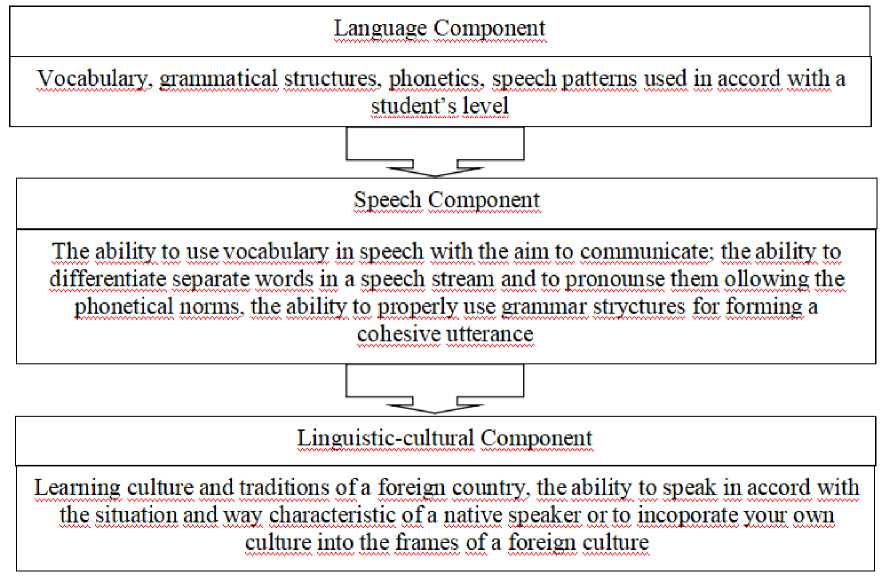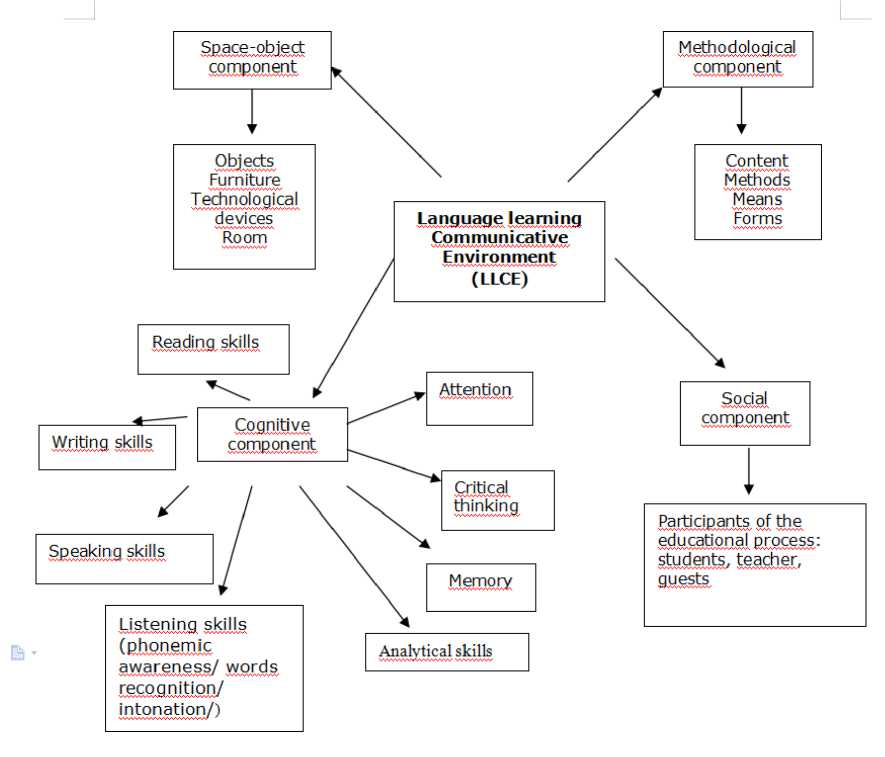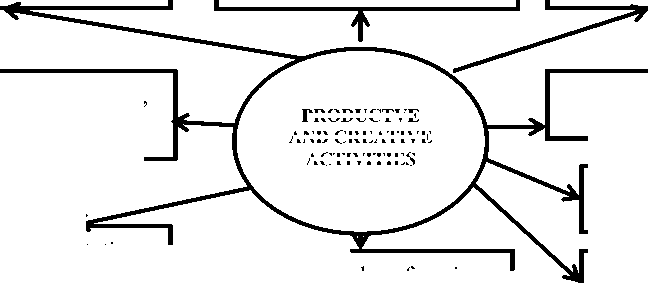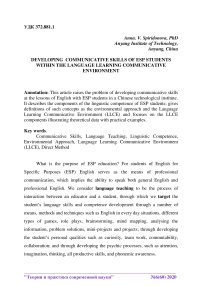Developing communicative skills of ESP students within the language learning communicative environment
Автор: Spiridonova A.V.
Журнал: Теория и практика современной науки @modern-j
Рубрика: Образование и педагогика
Статья в выпуске: 6 (60), 2020 года.
Бесплатный доступ
This article raises the problem of developing communicative skills at the lessons of english with esp students in a chinese technological institute. It describes the components of the linguistic competence of esp students; gives definitions of such concepts as the environmental approach and the language learning communicative environment (llce) and focuses on the llce components illustrating theoretical data with practical examples.
Communicative skills, language teaching, linguistic competence, environmental approach, language learning communicative environment (llce), direct method
Короткий адрес: https://sciup.org/140289661
IDR: 140289661 | УДК: 372.881.1
Текст научной статьи Developing communicative skills of ESP students within the language learning communicative environment
Communicative Skills, Language Teaching, Linguistic Competence, Environmental Approach, Language Learning Communicative Environment (LLCE), Direct Method
What is the purpose of ESP education? For students of English for Specific Purposes (ESP) English serves as the means of professional communication, which implies the ability to speak both general English and professional English. We consider language teaching to be the process of interaction between an educator and a student, through which we target the student’s language skills and competence development through a number of means, methods and techniques such as English in every day situations, different types of games, role plays, brainstorming, mind mapping, analysing the information, problem solutions, mini-projects and projects; through developing the student’s personal qualities such as curiosity, team work, commutability, collaboration; and through developing the psychic processes, such as attention, imagination, thinking, all productive skills, and phonemic awareness.
From our point of view, intergrating real life into the language education promotes, first of all, the formation of a positive motivation towards learning a foreign language. Secondly, familiarizing a student with a different culture also has a positive impact. Thirdly, the range of sources available for the practice of a foreign language has widened. One can watch English educational and professional programs or TV series on the Internet, TV or listen to original conversations in talk shows, read English books and talk with peers via Skype, Zoom, WeChat or any other chat program. The best option, however, is to go abroad and to immerse oneself in the natural language environment, which is the powerful mechanism that enables the passive knowledge of the language to become transferred into an active one.
Sometimes students start loosing their motivation saying that their brain is not able to acquire it. It is a scientifically proven fact that the left hemisphere of the brain is responsible for speech, although today more and more facts support the idea that different areas of brain participate in the language development, which means that we can learn during our whole life. The researcher Fred Genesee points out that recent findings indicate that the specialized functions of specific regions of the brain are not fixed at birth but are shaped by experience and learning. There is direct evidence that when learning occurs, neuro-chemical communication between neurons is facilitated, and less input is required to activate established connections over time. New evidence also indicates that learning creates connections between not only adjacent neurons but also between distant neurons, and that connections are made from simple circuits to complex ones and from complex circuits to simple ones. Effective teaching should include a focus on both parts and wholes [10].
Today English has entered our life in all spheres due to Globalization processes. An educated person cannot imagine his/her life without it: using the Internet, paying online on foreign sites, reading articles in the English language, watching commercials and listening to the radio programs, etc. The students should be able not only to understand English and express themselves but also to analyse the information using their critical skills and sift the wheat from the chaff. A student should acquire linguistic competence, develop critical thinking and be able to communicate successfully. Following D. Venkateswar Rao, we would like to emphasize that today we are dealing with Gliobal students in the Global world [11].
Defining the concepts «Linguistic Competence» and « Language Learning Communicative Environment (LLCE)» and having analysed the concept of competence (based on the works of E.A. Bystrova, N.D. Galskova, V.V. Safonova), K.B. Zhigaleva defines the linguistic competence and presents the indices of linguistic competence formation. The researcher considers linguistic competence to be the structural component of communicative competence, which is recognized by the academic society. According to the author, linguistic competence is a complex of components including both knowledge of vocabulary, grammatical structures, phonetic norms, words with cultural semantics and ability to consciously use them expressing student’s own desires and thoughts in an aural-receptive and productive ways [5, p. 11] . Thus Linguistic Competence can be presented as a three-component structure (Figure 1).
-
Figure 1 . Structure of the Linguistic Competence

The above indicated diagram can be extended by the components:
-
• Cognitive component - seen as the integrity of the language aspect, vocabulary, phonetics, and grammar; speech aspect – speech patterns, courtesy phrases, clichés; and analitical skills;
-
• Culture-oriented component - represented by original songs, poems, stories, conversations, games and plays, idioms, holidays and traditions of the country studied
-
• Emotional component - expressing itself in a stimulating environment with various emotinal reactions, positive thinking, numerous feelings a student experiences during the interaction between a teacher and himself/herself; between his/her peers.
The next two concepts we’d like to focus on are related to the language learning and the developing of the linguistic competence – these are
Environmental Approach and Language Learning Communicative Environment (LLCE).
From the point of view of Environmental Approach (D. Bruner, S.F. Sergeev, V.A. Yasvin [2; 8; 9]), the environment itself enables a student’s activity. The best way for a student to learn a foreign language is to immerse in the artificially created Language Learning Communicative Environment. What do we understand under this concept? There are different types of environment: “Studying the Definitions of the Environment” by N.B. Krylova [6], “Educational Environment” by S.F. Sergeev and V.A.Yasvin, “Learning Environment” by N.M. Alexandrova [1], “Developmental Environment” by L.S.Vygotsky [3], V.V. Davydov [4], V.A. Petrovsky [7], the Language Learning Communicative Environment can be defined as the environment of developmental education within the integrity of its components: the space-and-object component, the methodological component, the cognitive and social components which provide favourable conditions for natural language learning thus creating a positive emotional atmosphere and promoting the student to acquire skills of direct communication (without translation)( See Figure 2).
Space-object component includes items of furniture in the classroom, technology devices (a computer, a projector, a screen, a board), room and space. We utilise a wide variety of other items and substances such as: books, stationary, posters on the walls, personal belongings, etc. in order to facilitate the learning of a foreign language in the classroom.
-
Figure 2.

Figure 2. Model of the LLCE
The methodological component consists of the program content,
methodology, technology, techniques, means and forms of teaching. Teaching is realized through a natural method or immersion in the basis of real-life and educational situations. The choice of vocabulary and situations is realized in accord with the principles of frequency and compatibility. The majority of situations are close to natural ones. The advantage of the LLCE is that we can teach English in real-life situations such as routine time – greeting and saying good-bye at the beginning and at the end of the lesson, small talks on daily topics, routine situations, etc. A very important role is given to Jazz chants, small talks and tongue-twisters, which create both a favourable atmosphere during the lesson and help reproduce the authentic nature of the English culture.
LLCE triggers productive skills. We emphasize that each type of productive and creative activities transforms into independent forms of language teaching (Figure 3). By stressing this, the importance of each activity is implied. A students is able to express himself/herself in all of them due to the vital nature of each activity available. A student becomes active while chanting and creating their own chants, working out a mind map on the topic or singing and analysing this or that language phenomenon in a song. A student often doesn’t realize that at this very moment the process of education is being held and consequently is very responsive to what appears real and interesting to him/her.
Integration of activities is another characteristic feature, which is worth mentioning in this context. It often occurs when students perform several activities to fulfil the task.
Mind mapping and students’ created tasks
Creating Jazz chants
Routine activities, Duty procedures

PRODUCTVE
AND CREATIVE
ACTIVITIES
TPR
Posters creation and presentation
Singing and performing
Role plays and dialogues creation
A
Giving presentations on the topic
Story-telling
-
Figure 3. Types of productive and creative activities at English classes
The social component comprises emotions and forms of subject-subject interaction within the educational process. The epicentre of this interaction is the student as a language personality. The role of a teacher in the classroom consists of providing support for the students and helping them to acquire the language in the situations close to the real life. The participants in the educational process are not only teachers and students but also include teacher-assistants, guests, and other teachers. Students are apt to copy teachers by following their behaviour. The forms of subject-subject interaction are illustrated in Figure 4.

Figure 4 . The forms of subject-subject interaction within the language educational process.
The cognitive component includes a complex set of tasks and exercises aimed at the development of phonemic awareness, listening skills, visual and aural memory, attention, analytical skills, critical thinking, speaking, reading and writing skills.
To sum up, the Language Learning Communicative Environment (LLCE), from our viewpoint, is the most efficient means of the language learning and of forming the linguistic competence of ESP students. The Language Learning Communicative Environment makes it possible to integrate all types of activities aimed at triggering speaking. It creates conditions favourable for the acquisition of a foreign language. The positive result of the development of a linguistic competence in students depends on many factors, notably on the motivationof learning the language, educator’s competence, learning conditions, participants’ interactions, and the institution’s authorities’ contribution to the language policy and support in the LLCE organization.
Список литературы Developing communicative skills of ESP students within the language learning communicative environment
- Александрова, Н.М. Среда обучения - компонент образовательной среды [Текст] / Н.М. Александрова, Д.Г. Колодан // Мир психологии. - 2005. - № 1. - С. 210-220.
- Брунер, Дж. Культура образования [Текст] / Джером Брунер; пер. Л.В. Трубицыной, А.В. Соловьева. - Моск. высш. шк. социальных и экон. наук. - М.: Просвещение, 2006. - 223 с.
- Выготский, Л.С. Мышление и речь. Избранные психологические исследования [Текст] / Л.С. Выготский. - М.: АСТ, 2008. - 669 c. - c. 597.
- Давыдов, В.В. Проблемы развивающего обучения [Текст] / В.В. Давыдов. - М.: Академия, 2004. - 288 с.
- Жигалева, К.Б. Методика формирования лингвистической компетенции дошкольников на основе системно-ориентированного моделирования процесса обучения иностранному языку [Текст] / К.Б. Жигалева: автореферат дис.. канд. пед. наук / К.Б. Жигалева. - Нижний Новгород, 2009. - 24 с., с. 11


